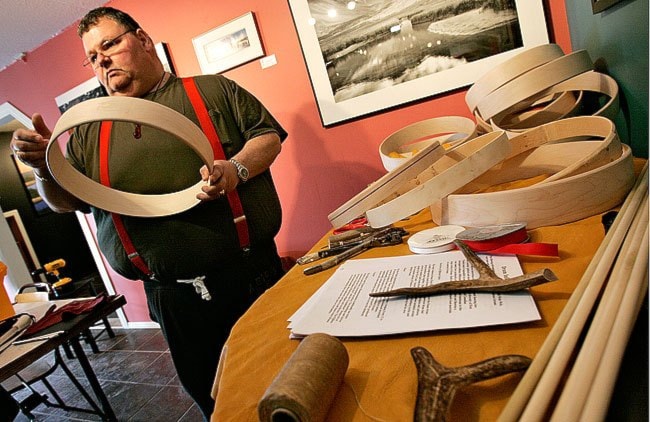Michel Labine, a French Metis from Fort Smith in the Northwest Territories, made his first drum at age six.
“It was made out of birch bark and squirrel pelt,” he says.
At that time, his family spent their summers in the bush. A taste for the outdoors stuck: Labine grew up to be a conservation officer. The job took him from Alaska’s towering Mount Mckinley to the fiords of Baffin Island.
His interest in drums stuck, too. So, when the Arctic Winter Games met in Yellowknife in 2008, Labine, now 50, used it as an opportunity to meet drummakers from around the circumpolar world.
Now he’s sharing what he’s learned. Today, he plans to meet with Yukon’s Rising Sun Singers to swap a drummaking lesson for their stories about the role drums played in the rituals of Yukon’s First Nations.
Tomorrow he’s holding a workshop at the Copper Moon Gallery that’s open to the public.
And on Sunday, from 3 p.m. on, an open drumming circle and bonfire will be held outside the gallery. It’s open to all.
Why drums? “Every culture in the world has a drum,” he said. “The drum is the heartbeat of a culture. It’s what keeps a culture strong.”
It’s also a piece of traditional knowledge that, for a time, was slipping away in parts of Canada’s North.
“The residential schools killed all the drumming,” said Labine. “They wouldn’t allow it.”
Which just made it more important to catalogue the different varieties of drums found across the circumpolar world.
The Dene drum has snares stretched across its back, which resonate with each drumbeat, adding another layer of complexity to the drum’s sound.
The Saami drum is almost egg-shaped, with a handle that’s laced into its back.
Gwitch’in in Yukon’s north beat their drums with a willow stick that strikes both ends of the instrument. “It almost acts like a snare,” he said. “Both sides reverberate.”
Workshop participants will learn how to make a Cree drum with a maple frame and a rawhide deerskin.
After 10 years of perfecting his technique, Labine can complete the laborious task of trying the rawhide skin to the wooden frame in about 40 minutes. He expects it will take about two hours for a participant’s first try.
He chose the Cree design because it’s unlikely to be familiar to any workshop participants in the Yukon. “It’s a level playing field,” he said.
The wooden frames have already been steamed and bent into shape. He uses maple. “It’s easy to bend, easy to work with,” said Labine.
Labine will also demonstrate how to make a traditional child’s toy: a rattle from deerskin and antler.
The rawhide must be soaked in water for several hours before it’s tied to the drum. As it dries it hardens and tightens, forming a taunt drum surface.
He’s learned plenty of lessons over his long apprenticeship as a drummaker. For instance: the wooden frame must be completely dry before the skin is mounted to it. If not, the taut skin will “twist the frame like a banana,” he said. “There’s a lot of tension when it’s dry.”
And he’s become a stickler for following the old rules. Some contemporary drummakers have taken to holding parts in place with white glue. That works for quite a while, said Labine, but eventually the glue gives and the drum breaks. He prefers the traditional, time-consuming method of using wooden dowel and hide laces.
Contact John Thompson at
johnt@yukon-news.com.
